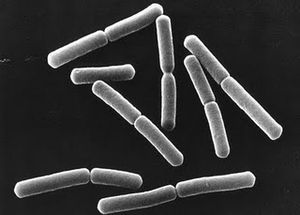Pseudomonas chlororaphis
==Classification== http://www.efsa.europa.eu/it/scdocs/doc/1431.pdf
Kingdom: Bacteria
Phylum: Proteobacteria
Class: Gamma Proteobacteria
Order: Pseudomonadales
Family: Pseudomonadaceae
Species
Pseudomonas chloroaphis
Sub Groups: aurantiaca, aureofaciens, chlororaphis, fragi, lundensis, taetrolens
Description and Significance
Describe the appearance, habitat, etc. of the organism, and why you think it is important.
microbewiki.kenyon.edu/index.php/pseudomonas Rod (1)
Metabolism
Aerobic (1)
Ecology
Found in soil, water, plant tissue and animal tissue.
http://www.efsa.europa.eu/it/scdocs/doc/1431.pdf effective biocontrol agent against Pythium aphanidermatum, the causal agent of damping-off of hot pepper in greenhouse vegetable production systems. Root colonisation by a plant-beneficial rhizobacterium. Pseudomonas chloroaphis O6, induces disease resistance in tobacco against leaf pathogens Erwinia carotovora causing soft-rot and Pseudomonas syringae pv. tabaci causing wildfire. It was reported to produce an antifungal metabolite which is a crucial trait in its competition with the pytopathogenic fungus Fusarium oxysporum in the rhizosphere. Specifically, P. chlororaphis was described to control tomato foot and root rot caused by Fusarium oxysporum by root colonisation.
"Pseudomonas chlororaphis strain 63-28 is a naturally occurring bacterium that can be used in controlling various fungi that attack crop roots. Its use is limited to vegetables and ornamental crops in containers in greenhouses. The product AtEzeTM, the first pesticide product containing this active ingredient, was registered in September 2001 for a period of 18 months. During that period, the registrant is required to submit additional data, which will allow EPA to decide whether to grant the product a full registration." (EPA, 2009)
Shown to increase the yield of spring wheat when soils are inoculated. (Crop et al, 1996)
Utilized in industrial production of acrylamide. (Yamada and Kobayashi, 1996; Asano et al, 1981)
http://www.efsa.europa.eu/it/scdocs/doc/1431.pdf A Pseudomonas chlororaphis isolate, obtained from perch intestine, was evaluated with regards to its potential to control Aeromonas sobria disease in farmed perch. An infection of perch with labelled P.chlororaphis indicated the bacterium is able to transiently colonise juvenile fish and fingerlings and to reduce A. sobria associated mortalities
Used as a soil inoculant in agriculture and horticulture by acting aginast certain fungal plant pathogens via production of phenazine type antibotics. (Chin-A-Woeng TF, et al. (2000). "Root colonization by phenazine-1-carboxamide-producing bacterium Pseudomonas chlororaphis PCL1391 is essential for biocontrol of tomato foot and root rot.". Mol Plant Microbe Interact 13 (12): 1340–5. doi:10.1094/MPMI.2000.13.12.1340. PMID 11106026.)
"Pseudomonas chlororaphis ATCC 43928 is a relatively common soil heterotroph which is capable of denitri- fication and is able to grow in a defined medium. This species is present in the root zone of G. maxima and even tends to dominate it after amendment with nitrate (Nijburg et al., 1997)." (Bodelier et al, 1997)
Genome Structure
Describe the size and content of the genome. How many chromosomes? Circular or linear? Other interesting features? What is known about its sequence?
Cell Structure, Metabolism and Life Cycle
Interesting features of cell structure; how it gains energy; what important molecules it produces.
Ecology and Pathogenesis
Habitat; symbiosis; biogeochemical significance; contributions to environment.
If relevant, how does this organism cause disease? Human, animal, plant hosts? Virulence factors, as well as patient symptoms.
References
http://aem.asm.org/cgi/reprint/65/8/3674
Author
Page authored by Brad J. Wardynski, Michael Wandersee, and Erika White, students of Prof. Jay Lennon at Michigan State University.
Pseudomonas chlororaphis
P. chlororaphis group
P. aurantiaca P. aureofaciens P. chlororaphis P. fragi P. lundensis P. taetrolens

